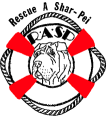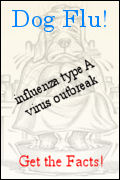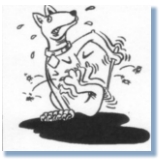|
|
Past Newsletters

The CSPCA Charitable Trust needs your support through donations to continue vital research projects. Your donation is tax deductible.

RASP (Rescue A Shar-Pei) is a volunteer group with a concern for abandoned and abused Shar-Pei in Illinois / Indiana / Wisconsin and surrounding areas.
|


|

|
|

Volume 1, Issue 2
August 1997
The importance of pre-surgical evaluation.
Veterinary surgery has made dramatic
advances in the last decade in terms of patient safety. We use safer anesthetic
agents; have more sophisticated monitoring equipment and better technical support.
There has also been an increased awareness and emphasis placed on the importance
of ore-surgical patient screening. This involves both blood testing and a urinalysis.
Why should this be done? Due to the incidence of kidney problems in our breed and
the young age at which it manifests itself, blood testing is extremely important.
I often see Shar-Pei who shows clinical signs of disease only after the condition
is very advanced. Blood testing allows us to pick up problems earlier when treatment
may be most effective. Pre-surgical blood testing also augments the physical exam.
By its very nature the physical exam can't tell us much about the internal aspects
of the dog. Blood testing gives us a more complete picture of the dog's overall health.
Lastly, blood testing gives us a good idea about what kind of surgical risk our
patient is. Perhaps there is underlying disease which should be treated before
surgery is contemplated. Or perhaps the tests indicate that there are some special
precautions that need to be taken or a different anesthetic protocol is necessary.
The use of presurgical blood screening is a useful modality to lessen the risks of
anesthesia and surgery in our Shar-Pei patients.
Anesthesia and Anesthetic Monitoring
Anesthesia is made up of the induction period, the
maintenance period and the
recovery period. It is very important that no food be given 12-18 hours prior to
anesthesia. This reduces the risk of vomiting with subsequent aspiration and
possible complications. Routinely we use an intravenous anesthetic to produce
enough sedation that a tube can be passed into the trachea and a gas anesthetic
can be administered. In Shar-Pei I often use an intramusculat sedative give in
the exam room while the owner is holding the dog.
Through experience I have learned that most Shar-Pei do not tolerate being put
into a cage and waiting for their surgery time. They often don't like being
physically restrained by strangers either. If you have to fight to restrain a
Shar-Pei in order to administer an intavenous anesthetic you can run into some
severe problems due to the "flight-or-fight" response. I've had many fewer problems
giving an intramuscular anesthetic in the exam room with the owner holding the
dog and then going right to surgery. I also use the safest gas anesthetic, isoflurane.
All Shar-Pei under anesthesia are placed on a heart monitor which monitors the
heart rate and gives an EKG visual display. Our technicians visually monitor all
the patients watching things such as respiration rate, mucous membrane color,
pulse, etc. I routinely administer fluids under the skin to all Shar-Pei patients
to make sure they have water intake to maintain kidney function.
While anesthesia in veterinary medicine is routine from the stand point of
being a common practice I consider it anything but routine from a safety factor.
There is always a risk when anyone, dog or person, is placed under anesthesia.
These risks can be greatly minimized by close attention to monitoring the anesthesia,
using state-of-the-art equipment, having good support staff and being prepared to
deal with any emergencies that may arise.
Mast Cell Tumors in the Chinese Shar-Pei
I've been very concerned about the increase in mast cell tumors I've been seeing
in our breed lately. Mast cells are a type of cell seen throughout the body in many
different tissues. These cells contain granules. Within the granules are substances
which are mediators of inflammation and are important in allergic and inflammatory processes.
Hives are often a result of degranulation of mast cells. Shar-Pei have a greater number of these
cells in their skin and underlying tissue. Mast cell tumors typically have an
ulcerated appearance and grow very rapidly. These are very aggressive tumors in
Shar-Pei and the best therapy is to remove them as quickly as possible with wide
surgical margins. Recurrence is common and spread to regional lymph nodes can occur.
Chemotherapy is not too effective.
Any skin mass in a Shar-Pei should be looked at ASAP. Often, mast cell
tumors can be diagnosed on fine-needle aspirate in the exam room. Surgery can
be curative in done early.
Allergies and the Chinese Shar-Pei
 Allergies are a major problem in the Chinese Shar-Pei and the Fall season is the
worst time of the year. "Hayfever" occurs in dogs just as it occurs in people and
the mechanism of the allergy is the same. The difference is in the target organ
involved in the allergic response - people develop respiratory disease such as
sneezing, runny eyes and nose, etc. and dogs develop itchy skin. The major symptom
of hayfever-type allergy in the dog is scratching and licking. This can be very
severe resulting in red skin, hair loss, sores and secondary bacterial infection
Allergies are a major problem in the Chinese Shar-Pei and the Fall season is the
worst time of the year. "Hayfever" occurs in dogs just as it occurs in people and
the mechanism of the allergy is the same. The difference is in the target organ
involved in the allergic response - people develop respiratory disease such as
sneezing, runny eyes and nose, etc. and dogs develop itchy skin. The major symptom
of hayfever-type allergy in the dog is scratching and licking. This can be very
severe resulting in red skin, hair loss, sores and secondary bacterial infection
How do we diagnose and treat allergies? There are really three ways to diagnose
the condition. The first involves skin testing. This is usually done by a veterinary
dermatologist (yes, there really are skin specialists in dogs!). This involves
injecting the various allergens such as pollen, etc. in the skin and seeing which
ones the dog reacts to Based on this information, a vaccine is developed containing
these substances and the dog is vaccinated to stimulate immune tolerance to these
allergens - a process called hyposensitization. This has about a 50-60% success rate.
The second method involves a similar process, but uses a blood test to determine
what the dog is allergic to. This method is known as RAST testing. Depending on
who you talk to this method is great or lousy. It still involves hyposensitization
shots. The main problem with both of these treatments involve the cost which can
easily be $500-700.
The last method involves guess work. Most hayfever allergies are seasonal and
based on this pattern one can assume that an itching dog in the Fall has hayfever
A more widely used form of treatment is drug therapy. Antihistamines can be used
in dogs, but don't seem to be all that effective. Also, there use often involves
a lot oftrial-and-error because there are so many available. Another drug therapy
is fatty acid therapy. This is effective in about 30% of the dogs. The mainstay
of drug therapy is cortisone, primarily prednisolone. This works very well, but
has serious side-effects with long-term use. Fortunately most of the allergy dogs
require its use for just a few months out of the year. Prednisolone is inexpensive
and works in virtually all the allergy cases.
The earlier treatment is started, the better. An initial exam is done to rule-out
other causes of itching such as fleas, mites, bacterial skin disease, etc. and a
cortisone injection is given to get immediate relief. Tablets are dispensed with a
decreasing dosage schedule to follow. In most cases the treatment can be stopped
as colder weather approaches.
Agility
Agility is the newest AKC performance event. It is a combination of obstacle course
, jumping competition and racing. The object of the event is to complete an obstacle
course consisting of tunnels, A-frame, dog walk, weave poles, teeter-totter, table and many
different types of jumps within a required amount of time with a minimum of deductions.
Deductions are taken for missed obstacles, missing too much time to complete the course.
This sport is excellent exercise for the dogs and the handlers. It is also mentally and psychologically
stimulating for the dogs. It is not nearly as regimented as obedience competition and is a lot more
fun for the dogs, the handlers and the spectators. It does require a physically fit
dog and conditioning is very important - it's not a sport that can be done once a
week and then let the dog be a couch potato the rest of the time. The handler also
has to be in reasonably good shape as well.
The Shar-Pei seems to do pretty well in agility. The sometimes have trouble with
the time requirement, but usually are very steady on the obstacles. Often, agility
classes and trials are held outdoors and some Shar-Pei don't tolerate the heat and
humidity well - always keep that in mind. Classes are not that easy to come by because
agility equipment is expensive and requires a lot of storage area. Agility also
requires a lot of space.
CONTACT FOR AGILITY CLASSES
- Blitzen Canine Academy:
Contact: Pam at 708 532-0939
- Creekwood Meadows - Mike Bond
708 552-9007
- Burr Ridge Dog Training Center
133 Tower Drive, Burr Ridge, IL 60521
708 257-2767 or 708 887-7668
- Smack Dabs Obedience Training, Inc.
30W125 Youghall, Warrenville, IL
Contact: Kathy at 708 357-9549
- Windy City Agility
The Centre at North Park
10040 W. Addison, Franklin Park
Contact: Lou at 708 279-4999
There are several agility organizations each with a slightly different bend to the sport.
- America Kennel Club(AKC)
Suit 200, 5580 Centerview Drive,
Raleigh, NC 27606-3390
919 233-9767
- North American Dog Agility Council, Inc. (NADAC)
HCR 2 Box 277,
St. Maries, ID 83861
208 689-3803
- United Kennel Club (UKC)
100 East Kilgore Rd.,
Kalamzoo, MI 49001-5598
616 343-9020
- United States Dog Agility Association, Inc. (USDAA)
P.O. Box 850955
Richardson, TX 75085-0955
214 231-9700
|
|

